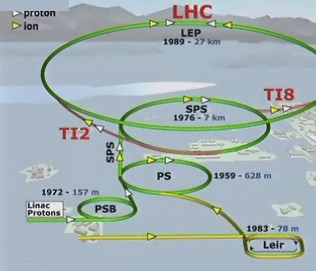 The fault that has shut down the Large Hadron Collider (LHC) will be hugely disappointing for scientists and engineers following the successful "start-up" of the experiment. The fault that has shut down the Large Hadron Collider (LHC) will be hugely disappointing for scientists and engineers following the successful "start-up" of the experiment.
It is now over a week since the first beams were fired around the accelerator's 27km (16.7 miles) underground ring. The crucial next step is to collide those beams head on.
But hopes that the first trial collisions would be carried out before the machine's official inauguration on 21 October now seem to have been dashed. It even looks uncertain whether this can be achieved before 2009.
The failure on 19 September - described as a "massive" magnet quench - certainly seems dramatic: it caused the temperatures in about 100 of the LHC's super-cooled magnets to soar by as much as 100C.
The fire brigade had to be called after a tonne of liquid helium leaked out into the LHC tunnel.
One of the LHC's eight sectors will now have to be warmed up to well above its operating temperature of 1.9 Kelvin (-271C; -456F) – which is colder than deep space – so that repairs can take place.
But the European Organization for Nuclear Research (Cern), which operates the LHC, maintains the setback is a relatively minor one in the grand scheme of things and poses no longer-term threat to the LHC.
"If you keep an eye on the big picture, we've been building the machine for 20 years. The switch-on was always going to be a long process," James Gillies, Cern's director of communications, told BBC News.
"A year or two down the line, this moment will be a distant memory, and we'll be running smoothly."
This incident is the latest in a line of setbacks during the construction and testing of this impossibly complicated machine built 100m beneath the French-Swiss border.
Flood threat
Serious difficulties were encountered when boring an artificial cavern designed to house the Compact Muon Solenoid (CMS), one of the LHC's massive detectors - which are designed to monitor beam collisions for interesting events.
The cavern shaft had to be bored through a 50m layer of glacial deposits – including fast-flowing water – which threatened to flood the hole.
Engineers had to create a 3m-thick wall of ice around the circumference of the shaft as a barrier to the underground rivers.
In April 2007, part of a magnet ruptured suddenly during pressure testing. The incident prompted an evacuation of personnel behind the tunnel safety perimeter.
Later that year, a problem was uncovered with a handful of "plug-in modules", or PIMs, which link the beam tube of one superconducting magnet to another. Engineers found sliding parts inside the modules had buckled into the beam pipe.
The LHC was expected to be complete by 2006, so a further delay of two months is unlikely to faze particle physicists who are waiting to begin harvesting data once the machine begins colliding its two beams of protons together at high energies.
The machine has more than 1,200 "dipole" magnets arranged end-to-end in the underground ring. These magnets carry and steer the proton beams which will whizz around the machine at close to the speed of light.
Chilling them to -271C – where even helium gas is turned into a liquid - makes them "superconducting".
This allows the magnets to conduct electrical current without resistance, thereby generating the large magnetic fields required to steer the beams while at the same time consuming relatively little power.
A quench occurs when part of a superconducting magnet heats up and becomes resistant to electrical current; the magnet essentially starts to lose its superconducting properties.
Engineers have a system in place to deal with this issue, but in this case, the quench created a hot spot in the magnet which got out of control and damaged hardware. The current problem appears to have affected the "bus bar" – a cable that carries current between the two magnets.
'Helium leak'
"What appears to have happened... is that there was a faulty connection in the bus bar," Mr Gillies told BBC News. He described this connection as a hi-tech version of a soldering joint to link the two stretches of cable together.
"The bus bar quenched, and that connection seems to have melted. The melting appears to have caused the helium leak.
"It seems to be a badly made connection – but this all has to be confirmed once we have had the chance to take a look at it."
The incident occurred during the final test of the last of the LHC's electrical circuits to be commissioned.
Cern says such problems are par for the course considering the vast complexity of the project. However, since the official start-up on 10 September, the organisation, which is based in Geneva, has had to deal with a level of media scrutiny it has never encountered before.
The two-month halt means there will now be a much smaller window in which to try for the first low energy collisions before the LHC shuts down for the winter – which is done in part to save money on electricity.
But Mr Gillies refused to rule anything in or out, and said a more complete picture of both the impact on the schedule and the nature of the fault itself would emerge next week, after engineers have had time to carry out their analyses.
| 